Reflections One Month After Montenegro EDCON 2023: Forward-looking Trends in Infrastructure and Applications
One Month After Montenegro EDCON 2023 Reflections: Infrastructure and Application TrendsAbstract
The main topic of EDCON2023 revolves around solving the blockchain Scalability Trilemma – Privacy, Scalability, and Decentralization. Vitalik Buterin’s The Scalability Trilemma proposed a clear direction for the development of Ethereum’s technology several years ago. In the past decade of Ethereum’s experience, infrastructure-level technology has continued to improve, and innovative applications have emerged one after another. However, we still have a long way to go from the beautiful vision, and each field of the “impossible triangle” requires more breakthroughs.
In 2013, Vitalik Buterin wrote the Ethereum white paper. Ten years later, the EDCON (Community Ethereum Development Conference) will be held in Podgorica, the capital of Montenegro. There was no grand celebration on site, nor was there any formalistic noise. What the author felt was that developers from all over the world were upgrading decentralization, privacy protection, and scalability in their respective fields to solve the “impossible triangle” of blockchain, seeking a collision of opinions, resource exchange, and win-win cooperation through communication.
Although there were no new “fortune passwords” or innovative ideas presented at the conference, it made people feel that it was the same old story of the Ethereum roadmap. However, the author deeply felt that the current AI revolution is gradually spreading to the blockchain. The significance of holding EDCON annually is to allow ecological developers to re-clarify the direction that Ethereum’s roadmap is aiming for, regularly review the progress of plan implementation, sort out the problems that urgently need to be solved, and discuss how to break through the “boundaries” of technology in their respective fields, such as how to achieve better privacy protection, scalability, provide higher security and stability, and how to create better user experience (UX, User Experience) and user security (US, User Security) for future applications. Participants exchange innovative points of view, stand at a global perspective to see the significance of various technological and cultural changes for the future of Ethereum.
- Can you earn money by running a node? How to choose a public chain? We talked to a node operator about it.
- Interpreting the Narrative of HOPE’s Resurrection
- Artificial intelligence data analysis tool KyberAI
During the stay in Montenegro, the author attended the EDCON2023 conference and a series of Side Events, including EDCON’s Community Day theme sharing, Super Demo exhibition, World Supercomputer Summit 2023, DAO Montenegro Conference, and Antalpha Labs’ Account Abstraction HackerHouse. In a limited time in Montenegro, there were still some events that the author wanted to attend but couldn’t, such as the ZK Community Breakfast and Zuzalu events. To make up for these regrets, the author interviewed friends who participated in these activities to understand their gains and feelings, summarized their own and peers’ gains, and shared them with everyone.
Summary of Key Takeaways
-
EDCON2023 focused on how infrastructure can overcome the scalability trilemma of privacy, scalability, and decentralization. The current stage is in the technical maturity of ZK, account abstraction, and L2, which provides a breeding ground for innovation in applications.
-
Zero-knowledge proof technology was widely discussed, including zkEVM, ZKML (Zero Knowledge Machine Learning), and opportunities for composability of ZK technology in various scenarios (Programmable Cryptography).
-
There was much discussion about on-chain gaming, account abstraction, and LSD, but there is still a need for innovation in the application layer.
-
ZKML is on the brink of an explosion, and AI may inject new vitality into blockchain technology empowered by ZK technology. The ZKML open-source community is worth looking forward to.
-
The account abstraction race is “flat, hot, and crowded,” and the challenge is to capture the value of the track.
-
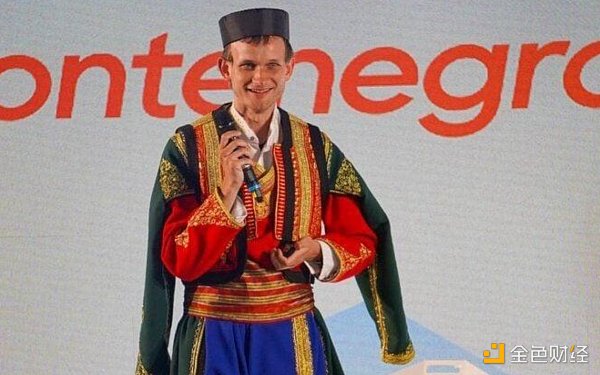
Vitalik Buterin speaks at EDCON2023 conference Source: UZMANCOIN.COM
Key Topics at EDCON2023
The main topics at EDCON2023 revolved around solving the blockchain trilemma of privacy, scalability, and decentralization. Vitalik Buterin’s The Scalability Trilemma, proposed several years ago, actually provided a clear direction for the technological development of Ethereum. In the past decade of Ethereum’s experience, the continuous updating and progress of infrastructure-level technology and the continuous emergence of innovation at the application level, but we still have a considerable distance from the beautiful vision, and each field in the “impossible triangle” needs more breakthroughs.
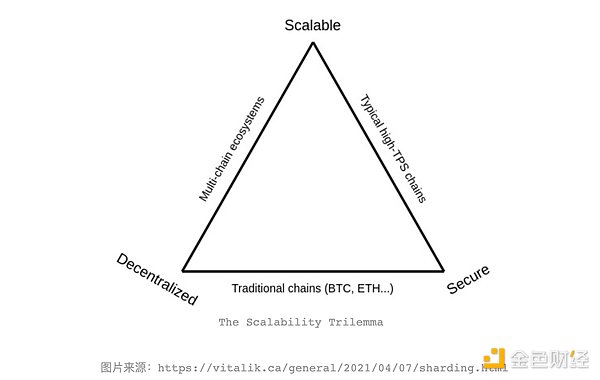
The author has summarized his own takeaways in the industry track and trend, divided into the infrastructure level and the application level. In the infrastructure field, the progress of zero-knowledge proof (ZKP) and Layer 2 (L2) networks received the most attention from speakers and attendees and was also one of the most discussed topics; in the DApp application development field, the main topics were around on-chain gaming, account abstraction, and the LSD (Liquidity Staking Derivatives) track.
It is worth mentioning that in the ZKP field, the discussions and trends at EDCON2023 and surrounding conferences show many “ZK+” combinable tendencies. Zero-knowledge proofs, as a means of privacy protection and scalability, are being tried in multiple fields on and off the chain. Cryptography is often customized, but the demand for more emphasis on generality (General-purpose) “Programmable Cryptography” has been discussed multiple times. In the application field, developers are more concerned about user experience (UX) and user security (US). Account abstraction improves UX and accelerates the “Mass Adoption” of blockchain, which seems to have become a prerequisite for application innovation discussions and a link that both infrastructure developers and application developers are working together to achieve.
The development of things follows the law of “the spiral rise of infrastructure and application fields”. EDCON2023 reviewed the current development status of the Ethereum ecosystem and trends in various fields, and developers are pushing forward the upgrade of infrastructure while waiting for the outbreak of applications.
1. Infrastructure
At the infrastructure level, the application of ZK technology in the blockchain and off-chain fields, including zkEVM (Layer 2 expansion solution), ZKML (Zero Knowledge Machine Learning), and Programmable Cryptography, is undoubtedly a high-frequency topic of this Black Mountain and a series of surrounding activities. Vitalik Buterin mentioned in his sharing that “ZK-SNARKs are going to be as important as blockchains in the next 10 years”, which has also become an important focus of attention.
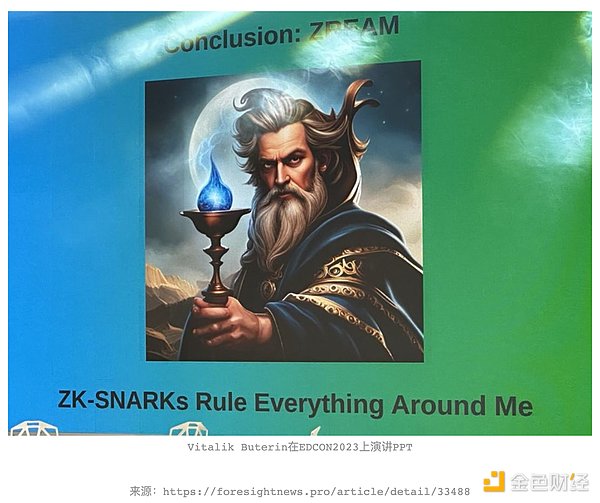
1.1 There is no shortage of new players joining the competition in zkEVM, and the track will remain highly active.
In the first half of 2023, we have seen many zkEVM projects go live on the mainnet, including Polygon zkEVM, zkSync Era, and Starknet. In the second half of 2023 to 2024, the industry may witness many more zkEVM projects going live on the mainnet, including Scroll, Linea, and Taiko, all of which are currently in the testing phase and collecting feedback from developers. All of the above-mentioned zkEVM projects have high exposure and participation in this EDCON2023 conference, and have appeared in the speeches of Vitalik Buterin and other guests many times, including emerging projects. The developers of zkEVM are passionate about their cause, sharing recent project progress and future goals with participants, expressing their expectations for technological progress and product updates, and the industry’s benign competition is evident. In the next 1-2 years, we will continue to see the second-tier network of zkEVM standing in the center of the Ethereum ecosystem.
Polygon zkEVM’s Technical Lead Jordi Baylina shared the latest developments of the Polygon zkEVM project at the conference, including improvements to the PIL2 (Polynomial Identity Language 2) language, the data compression scheme being implemented to improve data availability, and a reiteration of how Polygon zkEVM supports account abstraction through ERC-4337. He also shared his thoughts on the landscape of blockchain Layer 2 solutions. The author noted that Jordi discussed various data compression schemes used by Polygon zkEVM and the formal approval of EIP-4844, both of which will further reduce costs and greatly improve data availability on Polygon. Jordi believes that we will see more Layer 2 networks in the future, and the composability between the L2s in the Polygon ecosystem will be achieved through Proof Aggregation, which will help all Polygon L2 chains generate a single proof, increasing the composability between the L2 chains in the Polygon ecosystem.
The Kakarot zkEVM project also gained a lot of attention during and after the conference. Kakarot is a zkEVM project built on Starknet using the Cairo language and recently announced its financing news. The reason for the attention is that Vitalik Buterin is one of the investors, and other investors include the co-founders of Starknet and the official Starkware team. Kakarot co-founder Elias Tazartes gave a public speech at EDCON2023, showcasing the vision and mission of Kakarot, which was also mentioned by Vitalik Buterin in his speech. The highlight of the project is that it provides an EVM environment for Cairo-based Starknet, allowing Solidity developers to directly deploy applications to Starknet through Kakarot without having to reprogram in Cairo, thereby creating an EVM-compatible platform on Starknet. This means that many excellent EVM projects can be quickly deployed to Starknet, reducing the time and effort required for developers to maintain Cairo and Solidity code libraries. Although Kakarot sounds like it can be a Layer 3 on Starknet, the team will first focus on the Rollup-as-a-Service service, which is expected to be launched in Q4 2023. In an interview with Blockbeats, Elias stated that competition in the Layer 2 space will become more intense in the future. As a zkEVM platform, Kakarot will actively collaborate with Starknet, Polygon, Linea, and others, and welcomes Solidity and Cairo language developers from China to join forces in this field.
1.2 The demand for Programmable Cryptography is once again demonstrated.
Aside from zkEVM, ZK technology is being used in more and more scenarios, and the demand for Programmable Cryptography is becoming increasingly evident. Programmable Cryptography was formally proposed by 0xBlockingRC. With the emergence and updating of zk-SNARK and other cryptographic tools, more general-purpose cryptography helps more developers quickly implement encryption applications (such as in digital identity, reputation, etc.), without having to learn and develop privacy-related protection technologies from scratch. With more programmable cryptographic development tools, privacy encryption may be more widely applied to blockchain applications and off-chain computing and modeling. In Jason Morton’s “What Is Unlocked by Practical Zero-Knowledge Proofs?” speech, he also mentioned that “ZKP is becoming more programmable.” At the ZK Blockingnel guest roundtable discussion about zero-knowledge proofs, Programmable Cryptography was also mentioned multiple times by guests such as Vitalik Buterin, who are very much looking forward to this more general-purpose application of cryptography.
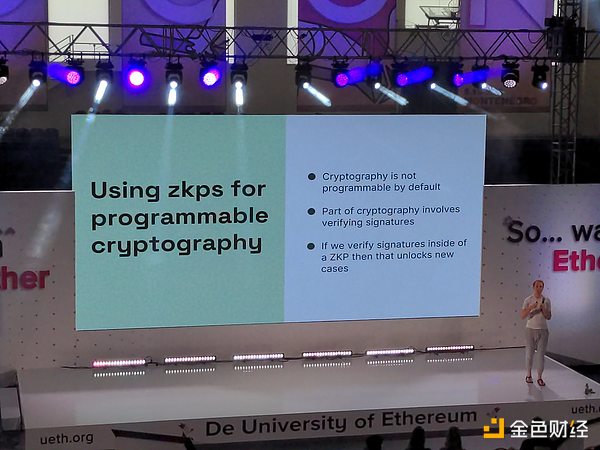
Barry Whitehat's speech at EDCON2023 source: https://twitter.com/search?q=programmable%20cryptography&src=typed_query
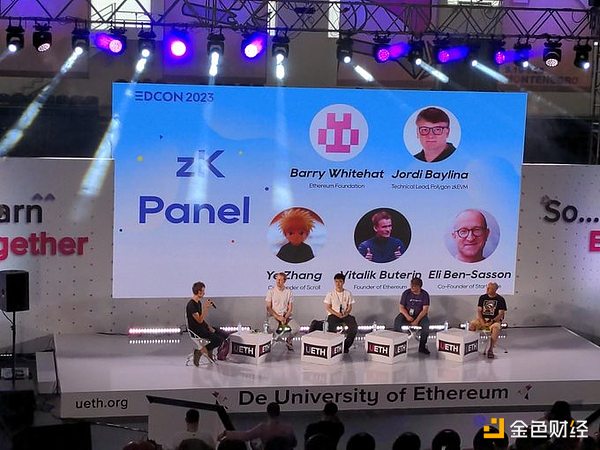
EDCON2023 ZK Blockingnel Roundtable Discussion source: https://twitter.com/madhavanmalolan/status/1660269927671156736
1.3 ZKML is in the early stages of development but has enormous potential
ZKML is the combination of Zero Knowledge and Machine Learning. As we all know, there are trust issues with machine learning models in many aspects: input and output information data, confidentiality or openness of algorithms and model parameters, etc. When trust issues exist, ML models face obstacles to achieving larger-scale applications. For example, when using personal information of users as raw data for training, there is a need for encryption of personal information; model parameters are usually the core competitive advantage of the developer team, and need to be encrypted to maintain competitive barriers. Zero-knowledge proof technology can provide proof for many things other than smart contracts, especially in the current environment where machine learning applications are becoming more common, ZKP can provide proof for an AI model with millions of parameters, thus improving security and privacy protection and helping to solve various trust challenges of machine learning models. In addition, machine learning models require a lot of computation, and when ML models are integrated into blockchain applications, ZK-SNARK can generate proofs to alleviate the computational power demand problem of ML and more efficiently introduce AI into blockchain applications. As artificial intelligence and machine learning further disrupt our lives this year, ZKML is becoming more and more known and recognized by people.
At EDCON2023 and many other blockchain conferences this year, we can feel that many blockchain developers have already joined the ZKML field (readers who still need to learn about this concept can read WorldCoin’s article on ZKML). As early as the second half of 2022, WorldCoin and some teams in the ZKML field created the ZKML community, and introduced the concept, advantages, and future prospects of ZKML to people in public occasions such as ETH Denver in 2023. At the first World Supercomputer Summit 2023 held in Montenegro, most of the keynote speakers were doing things related to ZKML. Cathie So (@drCathieSo_eth), a core member of PSE, introduced AIGC NFT EIP-7007 and described to the audience the innovative sparks that may be generated by combining ZK with ML, and further envisioned how the future World Super Computer Architecture will empower the realization of ZKML. The PSE team is committed to better integrating ZKP technology with the Ethereum ecosystem and actively participating in the research and projects of ZKML. In addition, Hyper Oracle (zkOracle project on Ethereum), Poseidon ZKP (ZK aggregation proof infrastructure), Modulus Labs (on-chain AI project development team), and WorldCoin’s DCBuilder are also keynote speakers at the first WSC conference. Among them, Modulus Labs, as a pioneer in the ZKML field, has conducted many experiments in the application of ZKML, including the DeFi Rockefeller Bot (the first full-chain AI trading robot), GameFi Leela vs the World (the first full-chain AI game), and NFT projects. At EDCON2023, Jason Morton, as a developer in the ZKML field, shared that he saw the number of FLOPS (Floating-point Operations Per Second) of ZKP increase rapidly over the past few years, but the Proof per Chain Transaction (the number of proofs in each on-chain transaction) is still at the level of ten thousand, he expects to achieve a breakthrough in the next three years. He envisioned that when Proof per Chain Transaction further increases to the level of 100 million or even 1 billion, there may be application scenarios combining ZK with blockchain in the fields of on-chain games, supply chain, payment transactions, and so on.
Many of the keynote speakers mentioned that ZKML is still in the early stage of development. As one of the pioneers in the ZKML field, WorldCoin’s ZKML community was established not long ago, but it has already attracted many developers and peers building in the field. As more and more products are led by AI, and more innovations come from the updates of AI and ML, ZK can be used as a means of privacy protection and accelerating computation, further empowering the society driven by AI. Although this demand is not very clear at present, if we have already foreseen a world where AI is everywhere, then the improvement of model and information encryption, and computation speed will be the rigid demand in the future. There are more and more programming tools in the market that can help developers create ZK proofs of AI models without learning all the cryptographic skills related to ZKP, which will open up a huge market for more ZKP DApps. The significance of blockchain to AI or ML will also be multi-level. The blockchain itself can provide immutable and decentralized on-chain records, and cryptocurrency itself can become a borderless currency system for AI and humans to coexist in the future.
[Note]: FLOPS, floating-point operations per second, is also known as peak speed per second, Floating-point operations per second, abbreviated as FLOPS, which is the number of floating-point operations performed per second, which is commonly used to measure computer processing speed or used to estimate computer performance.
2. Application of DApp
At the EDCON2023 conference, we heard more about the exchange and discussion of underlying technologies, and less about DApp applications, with on-chain games, account abstractions, and LSD tracks being the majority of the content.
2.1 On-Chain Gaming presents an AI trend
For applications, everyone still has high expectations for on-chain gaming. At the conference, when zkEVM public chain projects were asked what on-chain applications they thought had potential, most of them answered on-chain games. When Danilo Kim shared his life experience at Zuzalu at the conference, he mentioned the on-chain AI game projects Zuland and Zuzuland that were born during Zuzalu. During Zuzalu and EDCON2023, Small Brain Games’ AI-based fully on-chain game Network State, a TRPG game inspired by Slobbovia, also attracted attention. On-Chain Gaming presents an AI trend.
The reason why on-chain gaming has become the main topic of application discussion is not because on-chain games already have traffic, but because the market lacks new narratives. After the DeFi summer, horizontal competition between DEXs and vertical business expansion has made the head effect more and more obvious, but the head DeFi protocol has not created new hotspots for public chains. To lead the outbreak of traffic, we must not follow the old path; the NFT boom happened on Ethereum, but even Ethereum’s NFT lacked innovative power during the bear market. NFTs that simply tell IP stories require a lot of operational energy and time, and NFTs with more GameFi elements and metaverse narratives require development time. The utility type and membership type NFTs require a large number of traditional companies to enter, and large-scale outbreaks also require user education and long-term planning and management of traditional brand’s own operational technical teams. Because of the addition of more AI/ML elements this year, the flexibility and richness of the on-chain gaming track have increased. For example, ZKML brings Autonomous NPC or AI God roles to on-chain games, bringing some new inspiration to on-chain games, and ZK is a hot topic, so the On-Chain Gaming track naturally receives more expectations. However, no matter which application track, it faces more challenges in leading the narrative to bring a large amount of traffic during the bear market. Therefore, when it comes to applications, the answer is always anticipation, but there is no very clear direction.
2.2 Account Abstraction is a highly competitive field, and capturing value in the space is a challenge. The concept of Account Abstraction (AA) has been around since the birth of Ethereum, and recent protocol standards, particularly the deployment of ERC-4337 in March 2023, have once again drawn attention to this concept, sparking “enthusiasm” in startups and investors. However, the current reality is that the account abstraction space is already quite crowded and competitive, and there are challenges for participants in capturing value and business models.
During EDCON2023, Antalpha Labs held a HackerHouse event focused on the topic of account abstraction, inviting developers, investors, and researchers in the field to share their insights and interact, including ComBlockchains DAO, Candide Wallet, Account Labs (UniBlockchains and Keystone merged), as well as L2 Mantle Network, ComBlockchains DAO, Mirana Ventures research team, among others, who support account abstraction. The one-week HackerHouse event was attended by the author who listened to the guests’ sharing several times and gained a lot, providing a deeper understanding of the current development status of the space. Also, thanks to Antalpha Labs for holding the HackerHouse event and opening it up to participants for learning in an easy communication environment.

At the current stage, many wallet projects, underlying public chains, and emerging startup teams are working hard to implement and land Account Abstraction-related businesses. During the Black Mountain period, the author participated in the EDCON2023 Community Day event and Antalpha Labs’ Account Abstraction HackerHouse. After listening to the sharing of various account abstraction projects, the author felt that the account abstraction space was “flat, hot, and crowded.” “Flat” is that the technical level and functional differentiation of account abstraction SDK and wallet projects are not significant, and there are no outstanding leading teams or products in the space; “hot” is that investors and entrepreneurs have been enthusiastic about account abstraction wallet projects in recent years, and the atmosphere of various conferences and peripheral activities can feel that account abstraction is the trend, and more and more smart contracts will naturally be developed using AA SDK, with built-in wallets supporting account abstraction, and public chains will also be more inclined to directly support account abstraction (such as Starknet, zkSync, etc.); “crowded” is that there are many participants in the space, which has also led to fierce competition in the space.
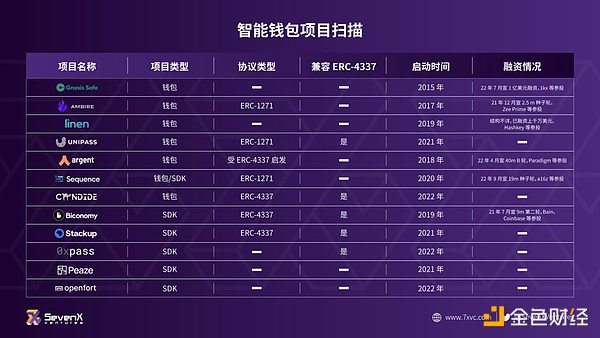
SevenX's project information on the account abstraction track comes from: https://foresightnews.pro/article/detail/23205
Multiple wallet teams within the track have already developed excellent products, and in terms of technology and development progress, there is no project that is far ahead and difficult to catch up with in the track, with each competitor almost maintaining a “neck and neck” state. In terms of SDKs for account abstraction, there are already multiple SDK providers, such as Gnosis Safe, Biconomy, Alchemy, Web3Auth, Etherspot and other teams. In recent years, almost all wallet projects have been developed based on the ERC-4337 protocol, and they tend to focus more on the B2B2C business model, as well as on the development experience for B-side application developers and the user experience for C-end users. In terms of functionality, social recovery, anti-censorship, no mnemonic, privacy protection, multi-chain and other functions are almost essential options. In addition to SDK providers, wallet projects have also made many attempts and efforts to explore more applications of account abstraction. The logic behind this is that when account abstraction is more widely applied and implemented into smart contracts, capturing the smart contracts (B-side) with large C-end traffic can enable the wallet itself to achieve value capture, which is also the reason why the wallet track has to vertically expand its business in the B2B2C business model. In addition to creating scenarios, some wallet projects are also working hard to build infrastructure, including developing SDKs, etc., in order to acquire customers. However, in the value capture link, many SDKs are public goods and are difficult to help SDK projects achieve value capture. Wallet-as-a-Service charging per use leads to difficulty in scalability, and MEV income also faces competition. Many leading wallet projects are also exploring more possibilities in the value capture link.
With the official deployment of ERC-4337, account abstraction has gradually landed in applications, and protocol landing is an important link to improve the on-chain UX and US, and it will be an important tool to bring mass adoption. Currently, the account abstraction track is fiercely competitive, with both SDKs and scenario applications exploring how to open up more users. The B2B2C business model of wallets is gradually forming, but effective economic value capture methods in the industrial chain are still being explored.
2.3 The long-term investment in the LSD track has certainty
If On-chain Gaming is the most discussed application among Ethereum developers in formal public occasions, then LSD and LSD-Fi are the topics that I hear more people discussing after the meeting. The speakers have discussed “decentralized nodes” many times, and how to strengthen the decentralization degree and stability and security of POS nodes are all technical points that developers continue to explore. In the process of exchanging ideas with the investors participating in the conference, the cryptocurrency funds have shown confidence in the LSD track, perhaps because during the bear market period, the LSD track centered around the POS mechanism is a relatively high certainty and stability area. Readers can read Mint Ventures’ recent research report on the LSD track for more information about research on the LSD track:
-
Shapella post-upgrade: long-term effects on yield, competition, and LSD-Fi
-
Quick view of pSTAKE project: LSD waist project supported by Binance
-
The encrypted interest rate market is coming? In-depth analysis of LSD interest rate market service provider Pendle
Conference Takeaways
1. ZKML is on the brink of explosion, and more machine learning applications will adopt ZK encryption in the future
This year, we have seen more and more AI-driven products that disrupt the way we live and work. Machine learning (ML), an important subset of AI, has been applied to many off-chain scenarios. The exploration of ML on the chain faces challenges such as computing costs and speed, model trust, and privacy protection. ZK encryption can enable ML models to generate proofs for models off the chain, empower smart contracts on the chain, and make smart contracts more intelligent and flexible. With ML entering the blockchain application, the industry has more imagination.
In recent years, ZK technology has matured in software and hardware, and a series of computational problems, trust problems, and privacy protection problems that existed in previous machine learning (ML) models can be solved using ZK methods. ZKML is also one of the fields that Sam Altman’s cryptocurrency project WorldCoin is striving to promote and develop. WorldCoin, along with many research teams and projects in this field, has jointly established the ZKML community to jointly research and promote ZKML technology and applications.
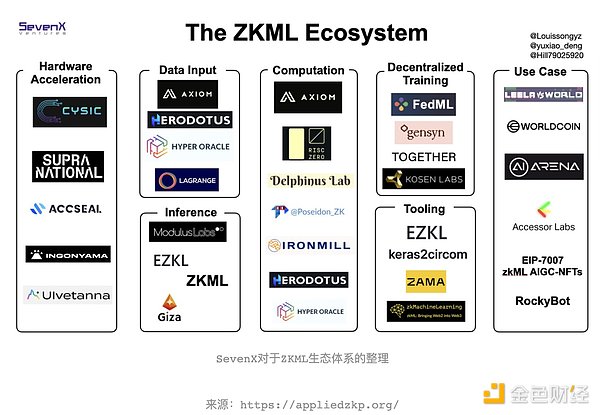
Currently, some existing ZKML applications are still in the early stages of development, such as on-chain AI trading robots, on-chain AI games, and using off-chain ML models to make suggestions for DeFi protocol parameters. The project being built by WorldCoin is similar to zk-DID, which uses ZKML to ensure the privacy of biometric information and supports future upgradability of Iris Code. In the future, we are expected to see more machine learning models entering the blockchain field, and ZK technology will make this “future” arrive faster.
In addition, I excerpted a page of Daniel’s PPT, the founder of Modulus Labs, at the WSC conference, “(The application of ZKML is) when AI is an excellent tool and there is’ trust ‘difficulties”. I think this is the underlying logic of the combination of ZK technology and AL/ML. When the concepts of AI and ZKML become more and more popular, we will see various pseudo-ZKML projects, but grasping the underlying logic and meaning of the combination of the two can avoid getting lost in hype and bubbles.
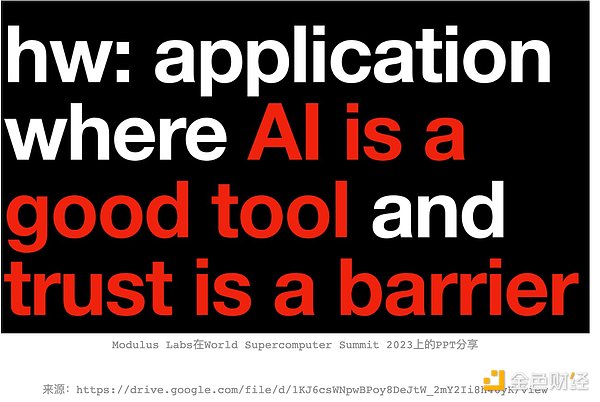
2. The Account Abstraction Track is “Flat, Hot, and Crowded”
As mentioned earlier, the concept of account abstraction has gradually begun to be applied. Based on the interviews and work exchanges conducted during and after the EDCON2023 conference, many wallet projects hope to lay out the entire industry chain in order to better connect the B2B2C business model. However, the more profound challenge faced by the track is the establishment of a value capture system. As mentioned earlier, fierce competition will make the account abstraction SDK a public good, making it difficult for B-side businesses in smart contracts to scale and compete. The C-side traffic of terminal users of wallets is still dominated by application DApps, which brings value capture challenges to many account abstraction wallet projects. However, for users, Ethereum will continue to promote ERC-4337 for larger and more profound applications, bringing better UX and US to users. I believe that in the next cycle, account abstraction will no longer be a concept, but a seamless and wonderful experience in a high-traffic application, which is worth looking forward to.
3. The importance of Public Goods in the blockchain industry has been mentioned multiple times
In the peripheral activities of this EDCON2023 conference, Buidler DAO, SeeDAO, and Mask Network jointly held the DAO Black Mountain Conference, which included public goods in its discussions. Scott Moore, the founder of Gitcoin, also discussed Public Goods, emphasizing the importance of “coordination” in helping blockchain protocols solve current social network problems. (Gitcoin, as an open source project funding platform, aims to build and fund digital public goods.) I happened to discuss the topic of public goods with Shumo, the founder of Manta Network and Poseidon ZKP, during the conference. “The endgame of blockchain infrastructure is public goods,” Shumo said. My understanding is that blockchain infrastructure is similar to “quasi-public goods” like roads, with limited non-competitiveness and limited exclusivity, and should be more widely used by society as a tool to improve the financial system, lifestyle, and work efficiency. The industry’s infrastructure code is usually open source, with reasons including the blockchain open source culture and atmosphere, as well as the equal and win-win spirit brought by the Web3.0 concept. This makes it difficult for infrastructure projects to be internally focused and maintained, as new open source projects will bring free positive externalities to the industry.
When interacting with other attendees, the author could feel that many Ethereum developers have little utilitarianism in their original intention. The starting point is usually to solve a certain problem or pain point in the Ethereum ecology, and the products or projects developed are usually open source for everyone to use and improve. Most of the underlying infrastructure of the blockchain is open source public goods, which is also one of the reasons why the cryptocurrency and blockchain industry can iterate quickly.

Summary
Andy Guzman of the PSE Foundation mentioned in his speech Harnessing ZK and Existing Infrastructure for Ethereum’s Mass Adoption that the current stage is in the maturity stage of ZK, account abstraction, and L2 technologies. The power of the three convergences will improve Ethereum’s User Experience (UX) and User Security (US). According to the future he described, we can imagine that on faster, safer, and more stable Layer 2, ZK encryption technology will empower AI/ML to provide more flexible DApp applications, while account abstraction will better help new users enter the field of cryptocurrency, and users will have more secure, convenient, and low-cost account experience and interaction experience. EDCON2023 will once again bring together developers and industry peers from around the world to examine the current development progress and status of Ethereum, exchange the latest trends in the industry, and collide with views to generate innovative ideas.
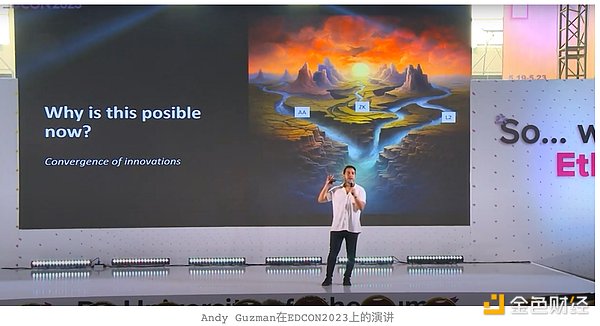
We will continue to update Blocking; if you have any questions or suggestions, please contact us!
Was this article helpful?
93 out of 132 found this helpful
Related articles
- Azuki Elementals sold out within 15 minutes and the floor price has dropped to 1.62 ETH.
- Can Reserve kickstart its growth engine with a $20 million investment in the Curve ecosystem?
- Azuki, who earned 20,000 ETH, has angered the entire community this time.
- Is Ethereum Ethscriptions going backwards? Will Eths replicate the Ordibehesht myth a thousand times?
- How will AI affect future work? A deep interpretation from the perspective of the productivity paradox.
- DeFi “Janitor” Poop: Recycling User’s Worthless Tokens to Achieve “Only Upward Movement”
- Refuting the Claim that MOVE Blockchain is a Consortium Chain from 12 Perspectives





